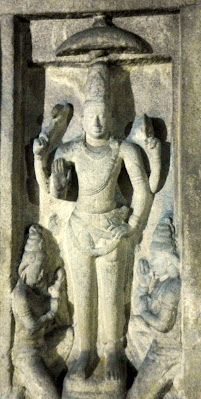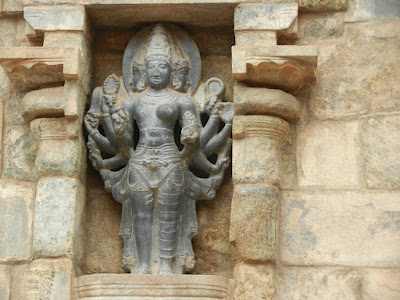In this paper, Nagaswamy explains the link between Ardhanari and Harihara, their depictions in verse, in Vedas and Puranas and in Tevaram hymns, and the reflection of these in sculptures and bronzes.
Poetry inspires Visual Images
Nayanmars
Appar and Sambandar sing the Ardhanarisvara form of Siva in their Thevaram
hymns on Thiruvenkadu, where there is a magnificent Chola bronze of the 11th
century. Consecrated 400 years after the saints, clearly the poets inspired the
devotee who commissioned it, says Nagaswamy. He cites another bronze of
Valampuram where a Vinadhara Bhikshatana described as “vaTTaNaikaL paTa nadanta naayakar” in an inscription, inspired by
this phrase from an Appar hymn. Such images are inspired by poetry.
“வட்டணைகள்
பட நடந்து மாயம் பேசி வலம்புரத்தே புக்கங்கே மன்னினாரே”
“தெரித்தொறு
வீணையராய் செல்வர் தம்வாய் சிறுமுறுவல் வந்தெனது சிந்தை வௌவ”
 |
| Bhikshaatana bronze, Valampuram temple |
And it
is poetry that helps us understand the common bond between Ardhanarisvara and
Harihara, which is explained thus with a quote from Appar : “Hari allaal devi
illai ayyan ayyaaranaarkkE”
ஹரி
அல்லால் தேவி இல்லை அய்யன் அய்யாரனார்க்கே (ஹரிஹரன்)
Such
references are not mere Saiva denigrations of Vishnu, as alleged by some
scholars. Harihara is Sung by Alwars and found in Vishnu temples like Namakkal.
 |
| Harihara, AdiVaraha temple, Mamallapuram |
The
links between Siva depicted as the Infinite Agni – Lingodhbhava, and Agnaa
Vishnu as mentioned in the Krshna Yajur Veda, in the Vaasordhaara hymn and its
counterpart Shaturudriya hymn are handled deftly. These explain the Ghora
(ferocious) and Shivaa (benign) aspect of Shiva respectively. Agni is dual
natured : it has Power that burns, and Power that illuminates.
“eri
allaadu uruvam illai” says Appar in another hymn linking Siva and Agni.
எரி
அல்லாது உருவம் இல்லை (அக்னி ரூபம்)
“रुद्रो
वा येष यद् अग्निः” says
the Veda. There is no rupa for Siva but
Agni.
 |
| Lingodhbhava, Kanchi Kailasanatha temple |
The Linga is a representation of the Infinte Agni, not primarily a phallic symbol, he argues, quoting extensively from the Kurma Purana and Vishnu Purana. Lingodhbhava is depicted extensively in temples from the earliest times. The depiction of Siva as Surya can be found in the aspects of
- Martanda Bhairava, depicted in Darasuram;
- the Dance of Surya, the Maheshvara;
- Gaja Samhara, as a metaphor of a sun emerging from a cloud, like Siva tearing apart the elephant;
- Siva Bhaskara
 |
| MaartaanDa Bhairava, Darasuram |
This is also to be seen in the Cosmic Dance of Nataraja, always depicted with Sivakami as the sole witness to the final destruction of all creation. This is represented in the Cit Sabha in Chidambaram.
Effectively in this paper, Nagaswamy:
- Connects the three Aspects of Siva
- Quotes Veda, Kurma Purana, Thevaram to establishes the philosophy of equivalent duality of ArdhaNari and HariHara
- Introduces the poetic idiom and quotes later use in Inscription
- Shows Linga is the Agni form of Shiva - Nataraja & Surya
- Brings out Sculptural Aesthetic
- Refutes MacDonald and AL Basham about phallic Linga and Harihara as a cult that emerged in Vijayanagara period








